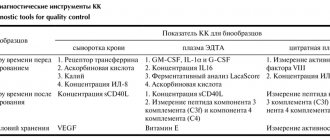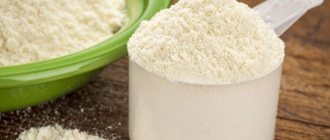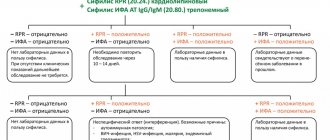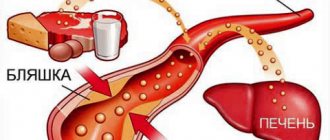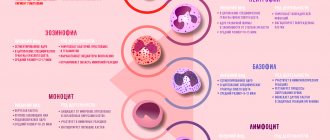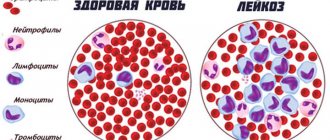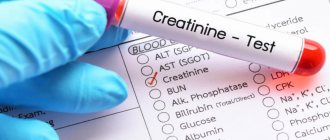A blood test for biochemistry is the most frequently prescribed test in gynecology, urology, endocrinology, oncology, dermatology and surgery. If you correctly decipher the information received, you can quickly diagnose diseases and metabolic disorders, even in cases where they do not give clear symptoms. It’s not for nothing that doctors call a biochemical blood test “truth serum.”
The cost of a comprehensive biochemical analysis is 1,510 rubles. The analysis includes determination of ALT, AST, glucose, serum creatinine (with determination of GFR), urea, total protein, total bilirubin, total cholesterol. CONSULTATION WITH DOCTORS ON THE RESULTS OF ULTRASOUND AND ANALYSIS - 500 rubles. (optional)
CLICK TO SIGN UP
To ensure that the analysis results are truly useful, we recommend that you read this article before going to the laboratory.
What is a biochemical analysis and why is it prescribed?
The content of the article
Biochemical blood testing is the most important diagnostic measure, which makes it possible to obtain an accurate assessment of lipid, protein and carbohydrate metabolism. These indicators are important for a huge number of pathologies and diseases, and therefore blood biochemistry is considered one of the basic tests of laboratory diagnostics.
The content of biochemical substances is assessed by their concentration, which is compared with normal values. If the concentration of a particular factor deviates from the norm, conclusions are drawn about the likelihood of a particular disease.
Sources
- Laboratory tests for the study of specific proteins / Ed. Yu.I. Yarets. Gomel. 2015. 64 p.
- Proteins in blood and urine. Analysis of proteinograms and clinical diagnostic significance. Candidate of Biological Sciences, Associate Professor Gorelaya M.V. Dnepropetrovsk 2015.
- Clinical laboratory diagnostics: textbook / Ed. V.V. Dolgova, Federal State Budgetary Educational Institution of Further Professional Education "Russian Medical Academy of Continuing Professional Education". – M.: FGBOU DPO RMANPO. 2021. – 668 p. ISBN 978-5-7249-2608-9
- Clinical laboratory diagnostics: teaching method. manual for students of medical, pediatric and medical-psychological faculties / S.V. Lelevich, V.V. Vorobiev, T.N. Grinevich – Grodno: GrSMU, 2011. – 166 p.
- Abumuslimov S.S., Magomedova Z.A. Total protein and protein fractions in blood donors in Grozny according to automated analysis // Bulletin of KrasGAU. 2021. No. 6.
- National Association for Clinical Nutrition. Clinical recommendations for the diagnosis and correction of nutritional disorders. Moscow 2013.
- MP 2.3.1.2432-08 Norms of physiological needs for energy and nutrients for various groups of the population of the Russian Federation.
- Druzhinina, N. A. Malnutrition in childhood / Druzhinina N. A. - Moscow: GEOTAR-Media, 2021. - 160 p. — ISBN 978-5-9704-5164-9.
Preparing for blood collection
A biochemical blood test, like any other, requires simple preparation. These measures must be taken very carefully, since any violation will affect the properties and composition of the blood. Conditions for accurate results:
- Have a low-fat dinner the night before donating blood, and do not drink coffee or strong tea. Immediately before donating blood in the morning, do not eat anything, you can only drink water.
- A day before the appointed date, refrain from visiting the bathhouse or sauna and do not overwork yourself.
- Donate blood for biochemistry before other procedures, if any have been prescribed (x-rays, injections, IVs, massage).
- To determine your sugar level most accurately, do not drink coffee in the morning or even brush your teeth.
- If you are taking medications that reduce lipid (fat) concentrations, you should stop taking them two weeks before the test, if possible.
- Limit the use of hormones, antibiotics, diuretics and other drugs for a while. The doctor referring you for the procedure will tell you for how long and which tablets will need to be postponed.
If a repeat examination is scheduled, take it in the same laboratory and at approximately the same time. Each laboratory uses its own methods and reagents, so results will vary between laboratories.
How to take the test correctly
To determine triglycerides, blood is taken from a vein. Before the analysis, preparation is prescribed:
- 3-5 days in advance, it is necessary to agree with the doctor on the possibility of using medications: diuretics, hormonals (including contraceptives), hypoglycemic drugs based on metformin, anti-cholesterol drugs;
- within 24 hours, give up alcohol, overeating, severe dietary restrictions, physical and emotional overload;
- 12 hours in advance you cannot eat, drink juices, sweet drinks, or smoke.
If the timing of meals is disrupted (the patient had breakfast in the morning or drank tea with sugar), then triglycerides can increase 6-8 times compared to the norm. It is also very important to take into account daily fluctuations in blood lipids. It is necessary to donate blood in the morning and to accurately confirm the results at least twice.
Expert opinion Alena ArikoExpert in the field of cardiology Over the course of a month, there may be changes in the concentration of blood fats within 25-45%, down or up. This is called biological variation and reduces the diagnostic value of a single test.
What indicators are most important in a biochemical blood test?
The diagnostic markers of a biochemical blood test are the following indicators:
- Blood glucose
. The most important test demonstrating the functionality and normal functioning of the endocrine system, liver and pancreas. This indicator is the main diagnostic parameter in identifying diabetes mellitus. - Total bilirubin
. This substance is a pigment that is formed as a result of the destruction of hemoglobin. This happens with the active destruction of red blood cells, with disruption of the liver (jaundice, cirrhosis), as well as as a result of disturbances in the outflow of bile. - Direct and indirect bilirubin. This indicator represents a separate fraction of the total bilirubin level and increases with disturbances of bile outflow, which is primarily characteristic of jaundice. The difference between the values of total bilirubin and the fraction of direct bilirubin is called an indirect indicator.
- AST (AST) and ALT (ALT)
- these indicators are enzymes, the main place of production of which is liver cells. That is why an increase in the concentration of these substances in the blood may indicate destructive processes in the liver, heart and other internal organs. - Gamma-GT
(gamma-glutamyltransferase) is an enzyme whose increased concentration indicates pathology of the liver or pancreas. Alkaline phosphatase is another enzymatic factor that is normally detected in the blood in small quantities. An increase in alkaline phosphatase levels indicates diseases of the liver and bone structures. - Total cholesterol
is an important indicator that demonstrates liver function and the patient’s nutritional pattern, since this substance enters the body with food. Low-density lipoproteins (LDL) are the most important characteristic that can early signal a high risk of the formation of atherosclerotic plaques in blood vessels. - Triglycerides
are one of the main characteristics of fat metabolism in the body. - Total protein
- demonstrates the overall level of protein components in the blood, and allows you to identify disorders in the liver and the presence of an infectious-inflammatory process.
Also, a biochemical blood test takes into account the level of albumin, potassium, sodium, chlorine, iron, creatinine, uric acid, urea and C-reactive protein.
Effective ways to lower triglycerides
A high level of TG in the blood is not a reason to panic. If you start treatment in time, the situation can be corrected. There are several main ways:
- nutrition adjustments;
- playing sports;
- taking medications.
Sometimes one component is enough. Most often, diet and exercise are used together. If these methods do not give the desired effect, medications are added.
Proper nutrition
By changing your attitude towards food, you can improve your body’s health and reduce the risk of developing most diseases. To do this, you need to focus on the right products. Be sure to include fish and other seafood in your menu. They are enriched with healthy proteins and amino acids. Salmon, shellfish, crabs, and oysters are suitable.
According to research from the University of Oregon, daily consumption of such foods reduces TG levels in the blood by 50%.
It will be useful to enrich your diet with dried beans and garlic.
To achieve lasting results, you will have to exclude the following:
- sweets (sugar, cakes, pastries, baked goods);
- fatty meat, lard;
- semi-finished products (sausages, frankfurters, sausages);
- sweet juices, soda;
- alcoholic drinks.
Products to avoid - gallery
Alcohol
Carbonated drinks Sweets and flour products Convenience foods Fatty meats
Physical activity
Physical activity reduces fat mass and normalizes TG levels. Take every opportunity - walk a few stops, take the stairs instead of the elevator, do exercises while watching TV. Ride a bike, go for a run. The main thing in the approach is regularity.
- Blood cholesterol levels - table by age. Cholesterol in the blood - norms for women, men and children
Taking medications
Sometimes it is not possible to avoid taking pharmacological drugs. This is especially true for patients in the older age group and people with a high degree of obesity. The following means are used:
- Fish fat. Contains fatty acids (Omega-3) in sufficient quantities. Effectively normalizes TG levels.
- A nicotinic acid. Reduces the production of dense lipoproteins by the liver.
- Fibrates. Organic compounds that attract and remove fat molecules.
- Satins. More used to lower cholesterol levels. The process of reducing triglyceride concentrations is also affected.
Explanation: normal biochemical blood test indicators in the table
| Index | Norm |
| Albumin | 35-45 g/l |
| Total protein | 63-87 g/l |
| Globulins | 21.2-34.9 g/l |
| Creatinine | 44-97 µmol/l in women and 62-124 µmol/l in men |
| Urea | 2.5-8.3 mmol/l |
| Glucose | 3.5-6.2 mmol/l |
| Uric acid | 0.24-0.54 mmol/l in women and 0.12-0.43 mmol/l in men |
| LDL | up to 3 mmol/l |
| Total cholesterol | 3.3-5.8 mmol/l |
| HDL | from 1.2 mmol/l in women and 1 mmol/l in men |
| Direct bilirubin | 2.2-5.1 µmol/l |
| Total bilirubin | 8.49-20.58 µmol/l |
| Alkaline phosphatase (ALP) | up to 260 units/l |
| Triglycerides | up to 1.7 mmol/l |
| Alanine aminotransferase (ALT) | up to 38 units/l |
| Creatine kinase (CK) | up to 180 units/l |
| Aspartate aminotransferase (AST) | up to 42 units/l |
| Gamma glutamyl transferase (GGT) | up to 33.5 units/l in men and up to 48.6 units/l in women |
| A-amylase | up to 110 units/l |
| Sodium | 130-155 mmol/l |
| Potassium | 3.35-5.35 mmol/l |
Concentration of protein and its fractions in a biochemical blood test
The role of protein (proteins) for the human body is invaluable. This is the main building material in the body, without which new cells, humoral immunity and transfer of substances do not occur. Typically, protein contains at least 20 amino acids; laboratory assistants also detect other elements - lipid residues, carbohydrates, vitamins and substances of inorganic origin (metals).
There are approximately 165 different types of proteins in the blood. The structure and functions of each are individual. However, all proteins can be divided into three groups: fibrinogen, globulins and albumins.
Biochemical analysis reveals two most important conditions:
- Hypoproteinemia
. When the amount of total protein decreases abnormally, we speak of hypoproteinemia. This phenomenon can occur due to poor nutrition (vegetarianism, protein-free diets), excessive blood loss, protein excretion in the urine due to kidney disease, burns, accumulation of large amounts of plasma in the abdomen, treatment with steroid drugs, impaired protein formation, and insufficient absorption of substances. - Hyperproteinemia
. Hyperproteinemia is an increase in the concentration of total protein in the blood. This phenomenon can be absolute and relative. An increase in protein levels due to the loss of the liquid component of blood plasma is considered relative. For example, with cholera and vomiting. An absolute increase in protein concentration is often observed in inflammation and multiple myeloma.
Indications for analysis
A study of total protein in the blood may be prescribed for the following indications³:
- general clinical medical examination;
- primary search for pathology of metabolic processes (metabolism);
- unexplained weight loss;
- swelling of the limbs, face;
- fatigue and severe weakness that does not correspond to the load;
- unexplained shortness of breath;
- the appearance of complaints from the liver or kidneys: chronic fatigue, arterial hypertension, increased abdominal volume due to intra-abdominal fluid, jaundice, pale skin, changes in the daily pattern of urination;
- eating problems, including eating disorders (anorexia, bulimia);
- suspicion of pregnancy;
- presence of signs of exhaustion;
- preventive examination for athletes, workers in heavy industries;
- monitoring the treatment or progress of diseases of internal organs;
- preparation for any surgical intervention.
Testing for total protein in the blood is the first step in diagnosing many diseases of internal organs and metabolic disorders. If the values deviate, the patient is referred for clarifying tests: determination of albumin or all protein fractions (proteinogram), leukocyte formula, erythrocyte sedimentation rate (ESR), hematocrit².
Disturbed pigment metabolism
In the human body there are specifically colored proteins. These are peptides that contain a metal (for example, copper or iron). Such peptides include cytochrome, hemoglobin, myoglobin, etc. As a result of the breakdown of peptides, bilirubin and its fractions are formed.
Free bilirubin appears after the breakdown of red blood cells in the spleen. This bilirubin is very toxic, especially to the human brain. However, the body is not poisoned due to the rapid connection of free bilirubin with albumin. In liver diseases such as cirrhosis and hepatitis, the concentration of bilirubin in the body increases due to a decrease in the amount of albumin and the predominance of glucuronic acid.
Indirect bilirubin binds to this acid, which loses its toxicity. It then enters the bile and is converted into urobilinogen. This enzyme, in turn, penetrates through the small intestine into the blood and then into the kidneys. It is urobilinogen that colors urine yellow.
Data on nitrogen metabolic processes
A too slow metabolic process, fasting, polyuria or liver failure will be indicated by an underestimation of creatinine, urea, and uric acid in the blood. Normal blood biochemistry values increase the likelihood of problems with the diseases in question.
An overestimation of urea is also possible. If it is found during blood biochemistry, then arterial hypertension, poisoning or kidney disease will be suspected. Readings above normal for uric acid are a sign of poisoning, infectious diseases, skin pathologies, gout, leukemia or diabetes. One of the signs of abnormalities in kidney function is also high creatinine. The indicator also signals diabetes mellitus, muscular dystrophy or obstruction in the intestinal area.
Why does jaundice appear?
There are several mechanisms for the occurrence of jaundice.
| Cause of jaundice | What's happening? |
| Increased breakdown of hemoglobin | Due to the too active production of indirect bilirubin, the liver simply cannot cope with its processing and excretion |
| Liver diseases | The amount of bilirubin produced does not exceed the norm, but the affected liver cells are not able to fully function and cope with their work |
| Impaired flow of bile | Instead of entering the intestines, bile accumulates in the liver and provokes its destruction. Bilirubin then enters the blood again. |
Jaundice is an indication for a biochemical blood test to determine the level of bilirubin in the blood. These indications also include liver tumors and cirrhosis, hepatitis, and hemolytic anemia.
Biochemical analysis and blood enzymes
Enzymes are proteins that help speed up chemical reactions in the body. The main enzymes are: ALP (alkaline phosphatase), ALT (alanine aminotransferase), CK (creatine kinase), GGT (gamma-glutamyltransferase) and AST (aspartate aminotransferase). They are found in large quantities in the pancreas, liver cells, heart, and muscles. There are few enzymes in the blood.
AST and ALT are involved in chemical reactions and are necessary for the transport of alanine and aspartate. These enzymes are found in muscle tissue, heart and liver. Elevated levels of ALT and AST in the blood are a sign of destruction of the cells of those organs in which an excess of the permissible norm was detected.
Reasons for increased AST and ALT:
- Myocardial infarction.
- Liver lesions.
- Hepatitis.
- Liver tumors and metastases.
- Destruction of skeletal muscles.
ALP is needed by the body as a way to deliver phosphorus to cells. Alkaline phosphatase can be bone or liver. The main reasons for increased levels of alkaline phosphatase in the blood:
- Cytomegalovirus;
- Hepatitis;
- Sarcoma;
- Metastases in the bones;
- Multiple myeloma;
- Liver damage from toxins;
- Osteoporosis;
- The healing process of bone fractures.
The purpose of GGT is, first of all, to participate in the transfer of cholesterol and fats into the cell. Most of all this enzyme is found in the kidneys, prostate gland, liver, and pancreas. The concentration of gamma-glutamyltransferase in the blood increases when:
- Diabetes mellitus;
- Alcohol poisoning;
- Liver diseases;
- Mononucleosis;
- Heart failure.
CC is aimed at maintaining energy metabolism in the cell at the required level. There are three types of creatine kinase:
- BB (location: brain);
- CF (heart muscle);
- MM (muscle tissue).
The level of CK in the blood increases due to destructive processes in these organs and tissues. This destruction occurs due to the following pathologies:
- Myasthenia;
- Gangrene;
- Encephalitis;
- Myorcarditis;
- Myositis;
- Amyotrophic sclerosis;
- Myocardial infarction;
- Treatment with prednisone;
- Schizophrenia;
- Sclerosis.
Causes of high protein
An increase in the amount of serum proteins is called hyperproteinemia. It can be absolute (impaired protein production due to organ damage) and relative (associated with changes in plasma volume).
Possible causes of hyperproteinemia²:
- severe dehydration (profuse diarrhea and/or vomiting, ketoacidosis in diabetes mellitus, insufficient water intake, massive sweating);
- extensive burns;
- autoimmune diseases, in which the body begins to produce a large amount of protein immunoglobulins that attack its own organs (rheumatism, systemic lupus erythematosus, sarcoidosis);
- Hodgkin's lymphoma (lymphogranulomatosis) - malignant lesion of lymphoid tissues;
- tumors of the blood and lymphatic system;
- chronic hepatitis in the active phase;
- liver cirrhosis in the initial stages;
- Waldenström's macroglobulinemia is a tumor that primarily affects the bone marrow and produces large amounts of monoclonal immunoglobulin M (IgM);
- peritonitis - active inflammation of the peritoneum;
- intestinal obstruction;
- kidney pathology in the phase of polyuria (excessive urination);
- cholera is an acute infectious disease (especially dangerous), accompanied by damage to the small intestine, massive diarrhea, vomiting and severe dehydration;
- acute and chronic infections.
Important!
Severe hyperproteinemia leads to impaired blood viscosity and improper circulation through the vessels. The most dangerous outcome is disseminated intravascular coagulation syndrome (DIC), in which thrombosis alternates with bleeding.
Alpha amylase
This enzyme is special. It breaks down complex carbohydrates into simpler compounds. Alpha amylase is concentrated in the salivary glands and pancreas. When examining blood, the doctor will definitely pay attention to the decrease and increase in the level of this enzyme.
Alpha-amylase exceeds the normal level in hepatitis, pancreatic cancer, pancreatitis, mumps, and renal failure.
A decrease in the level of the enzyme is observed with alcoholism, myocardial infarction, toxicosis during pregnancy, thyrotoxicosis, pancreatic necrosis, and taking steroid drugs.
Blood electrolytes
The most important electrolytes are sodium and potassium. Despite their minimal amount in the body, these substances are involved in almost all human processes and organs. Potassium is a kind of conductor of electrical impulses to the heart. Therefore, even minor changes in potassium levels negatively affect myocardial function. Hyperkalemia is an increase in potassium levels, and hypokalemia is a decrease.
- An upward deviation in the amount of potassium is fraught with arrhythmia, clouding of consciousness, slow heartbeat, and decreased blood pressure. This can happen when the indicator increases to 7.15 mmol/l.
- If the potassium level, on the contrary, falls below 3.05 mmol/l, then vomiting and nausea, difficulty breathing, cardiac and muscle weakness are likely to occur.
Sodium does not play any special role in the metabolic process. It is found in large quantities in extracellular fluid. Sodium has the function of controlling pH and osmotic pressure. The process of sodium production itself is controlled by aldosterone, a hormone of the adrenal cortex. Sodium is excreted in the urine.
The state of hyponatremia (low sodium level) leads to apathy, nausea and vomiting, refusal to eat, drowsiness, weakness, convulsions, and coma.
Hypernatremia (high sodium levels) causes seizures, irritability, muscle tremors, and twitching.
To summarize, I would like to note that each laboratory has its own research equipment and a set of reagents. Therefore, indicators may vary between institutions. Be careful when receiving the test result. It is important that the form contains information about the acceptable standards for all parameters of a biochemical blood test. Only in this case is it possible to interpret the data obtained correctly and identify possible deviations from the norm.
What do deviations from the norm indicate?
Quite often it is necessary to take a test such as blood biochemistry, so for many it is important to decipher the data obtained and normal indicators for comparison with those obtained in the laboratory. At the same time, the presence of any deviations does not indicate the fact of certain health problems, so it is worth finding out all the nuances from the doctor. The numbers are considered in aggregate and separately; they can only indirectly indicate the presence of possible diseases or deviations from the ideal state. We suggest studying normal blood biochemistry indicators, the reasons for underestimated or excessively high data in women or men.
